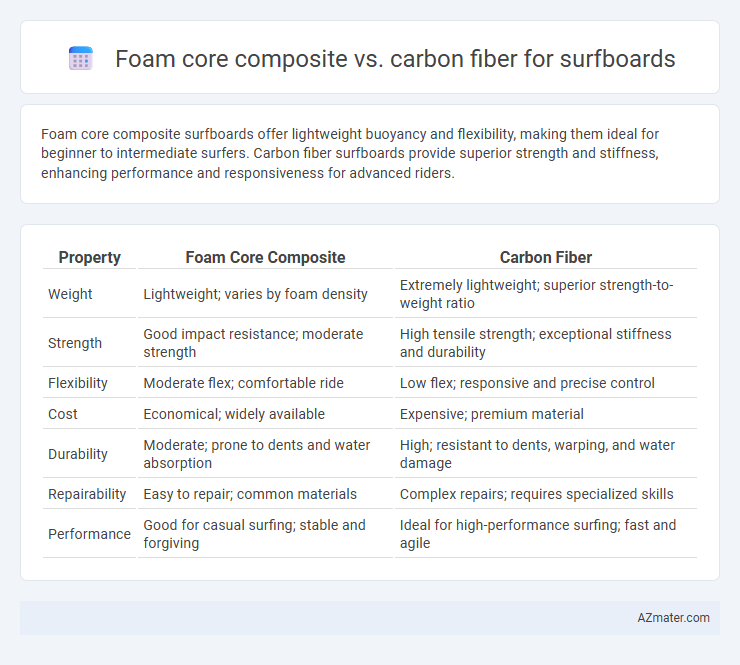Foam core composite surfboards offer lightweight buoyancy and flexibility, making them ideal for beginner to intermediate surfers. Carbon fiber surfboards provide superior strength and stiffness, enhancing performance and responsiveness for advanced riders.
Table of Comparison
| Property | Foam Core Composite | Carbon Fiber |
|---|---|---|
| Weight | Lightweight; varies by foam density | Extremely lightweight; superior strength-to-weight ratio |
| Strength | Good impact resistance; moderate strength | High tensile strength; exceptional stiffness and durability |
| Flexibility | Moderate flex; comfortable ride | Low flex; responsive and precise control |
| Cost | Economical; widely available | Expensive; premium material |
| Durability | Moderate; prone to dents and water absorption | High; resistant to dents, warping, and water damage |
| Repairability | Easy to repair; common materials | Complex repairs; requires specialized skills |
| Performance | Good for casual surfing; stable and forgiving | Ideal for high-performance surfing; fast and agile |
Introduction to Surfboard Construction Materials
Foam core composites and carbon fiber represent two predominant materials in modern surfboard construction, offering distinct benefits in weight, durability, and flexibility. Foam cores, typically made from polyurethane or expanded polystyrene, provide lightweight buoyancy and easy shaping, making them a staple for performance and recreational boards. Carbon fiber layers enhance strength and stiffness, improving board responsiveness and longevity, often favored in high-performance or custom designs.
What is Foam Core Composite?
Foam core composite surfboards feature a lightweight foam core, typically expanded polystyrene (EPS) or polyurethane (PU), sandwiched between layers of fiberglass or epoxy resin for strength and durability. This construction offers excellent buoyancy and flexibility, making foam core boards ideal for beginners and all-around surfing conditions. Compared to carbon fiber, foam core composites provide a cost-effective balance of performance and resilience, although they lack the extreme stiffness and lightweight properties of carbon fiber boards.
Overview of Carbon Fiber Surfboards
Carbon fiber surfboards offer exceptional strength-to-weight ratios, providing surfers with increased durability and enhanced performance on waves. The advanced composite material delivers superior stiffness and responsiveness compared to traditional foam core surfboards, allowing for quicker turns and better control in varying ocean conditions. These boards are favored by professional surfers for their lightweight design and ability to maintain structural integrity under high stress.
Weight Comparison: Foam Core vs Carbon Fiber
Foam core surfboards are significantly lighter than traditional wood boards but generally heavier than carbon fiber options. Carbon fiber surfboards offer superior weight reduction due to their high strength-to-weight ratio, often weighing up to 30-40% less than foam core equivalents. This weight advantage enhances maneuverability and responsiveness in the water, making carbon fiber a preferred choice for performance-focused surfers.
Strength and Durability Analysis
Foam core composite surfboards offer lightweight properties with moderate strength, but carbon fiber boards provide superior tensile strength and impact resistance, enhancing overall durability. The carbon fiber's anisotropic characteristics allow it to withstand higher stress loads and resist deformation better than foam core composites. This makes carbon fiber an optimal choice for surfers seeking long-lasting performance and structural integrity in demanding conditions.
Flexibility and Performance Differences
Foam core composites offer greater flexibility and shock absorption, making them ideal for surfers seeking a smoother ride and enhanced maneuverability in choppy conditions. Carbon fiber surfboards provide superior stiffness and responsiveness, translating to increased speed, precision, and power for advanced riders tackling high-performance waves. The choice between foam core and carbon fiber significantly impacts board dynamics, with foam cores favoring comfort and versatility while carbon fiber emphasizes performance and control.
Cost and Accessibility
Foam core composites offer a more cost-effective and widely accessible option for surfboard construction compared to carbon fiber, making them ideal for budget-conscious surfers and hobbyists. Carbon fiber surfboards, while significantly more expensive due to material and manufacturing complexities, provide superior strength-to-weight ratio and durability, appealing to performance-driven athletes. Availability of foam core materials is higher in local surf shops and online markets, whereas carbon fiber components often require specialized suppliers and fabrication expertise.
Environmental Impact Considerations
Foam core composite surfboards typically rely on polyurethane or polystyrene foam cores with epoxy or polyester resins, which contribute to significant environmental concerns due to their non-biodegradable nature and toxic manufacturing emissions. Carbon fiber surfboards, while offering superior strength-to-weight ratio and durability, involve energy-intensive production processes and the use of non-renewable materials that present challenges in recycling and disposal. Sustainable alternatives focus on bio-based resins and recyclable core materials to reduce carbon footprint and mitigate long-term ecological damage in surfboard manufacturing.
Suitability for Different Surfing Styles
Foam core composites offer enhanced buoyancy and flexibility, making them suitable for beginners and surfers who prefer longboarding or mellow waves. Carbon fiber surfboards provide superior stiffness and responsiveness, ideal for high-performance shortboarding and aggressive maneuvers. Choice between foam core and carbon fiber depends on the surfer's style, wave conditions, and performance requirements.
Choosing the Right Material for Your Surfboard
Foam core composite surfboards offer lightweight durability and increased buoyancy, making them ideal for beginners and intermediate surfers seeking maneuverability and stability. Carbon fiber boards provide superior stiffness and strength, enhancing performance with faster response times and increased speed, favored by advanced surfers aiming for high-level precision. Selecting the right material depends on your skill level, surfing style, and preferred wave conditions, with foam core composites excelling in versatility and carbon fiber boards targeting performance and durability in demanding environments.

Infographic: Foam core composite vs Carbon fiber for Surfboard
 azmater.com
azmater.com